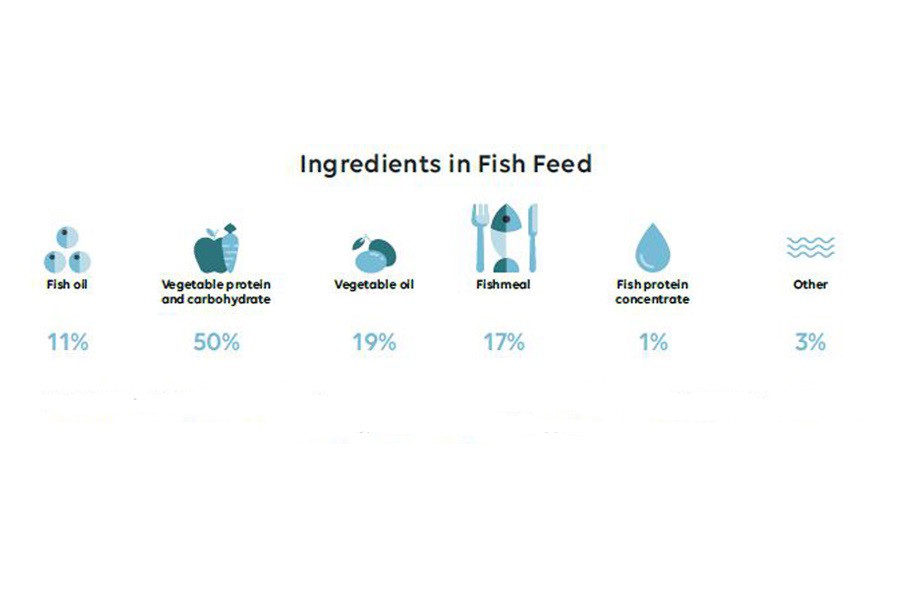Our fish feed ingredients should be from sustainable and traceable sources.
Lerøy Seafood Group has taken an active role in influencing the further development of feed composition to ensure product quality in a sustainable way.

Ingredients
We work actively to further the development of sustainable fish feed. Our fish feed ingredients should be from sustainable and traceable sources.
We normally divide the ingredients into two groups:
During the last years there has been a change in the composition of the feed to more and more use of vegetable raw materials.
Proportion of marine raw material
| 2020 | 2019 | 2018 | |
| Share marine raw materials % | 20 | 22 | 23 |
| Share vegetables % | 80 | 78 | 77 |
In 2020, the Group purchased 273 497 tons of fish feed.
CO2e for production of fish feed
| 2020, included landuse | 2019 | 2018 | |
| Average emissions per kg feed produced for the Group | 3,18 | 1,58 | 1,77 |
In 2020 we used the following marine raw materials:
In 2020 we used the following vegetable species
FFDR salmon
FFDR, salmon (ASC formula)
| 2020 | 2019 | 2018 | |
| FFDR m | 0.39 | 0.37 | 0.49 |
| FFDR 0 | 1.7 | 2.09 | 1.49 |
The data is verified by an independent third party.
Novel feed ingredients
The Group was one of the first to use new raw materials and has since 2017 used microalgae in fish feed. Through its interest, Lerøy has participated in the development of the supplier industry within microalgaes. When Lerøy started using microalgae, there was only one producer, today there are four.
Lerøy has also used insect meal the last years, but the available volumes offered today is too small for an industry and the costs are too high.
Through our work with novel feed ingredients Lerøy has invested significant values in the development of new raw materials for fish feed. An estimate based on 2020 averages says that Lerøy’s investment in novel feed ingredients is approx. NOK 220 million over the last 3 years.
To be able to justify the increased production costs, we depend on a competitive price for these raw materials. Today, price and production volume are not satisfactory to be able to justify an increase in volume to be included in the feed.
Lerøy has taken leadership in the pursuit of new and sustainable raw materials. We chose to focus on alternatives for marine omega 3 out of concern for fish quality, fish welfare, securing the supply and out of marine ecology concerns. Microalgae helps Lerøy to increase the level of EPA+DHA in the feed, addressing all the mentioned potential problems intertwined with fish oil from forage fisheries.
However, it is worth noting that we are not replacing any fish meal/oil in with novel ingredients today, rather increasing the level without further putting pressure on the marine wildlife. The reasoning behind this is complex. Lerøy takes our responsibility in assuring sustainably managed oceans with utmost respect. That can only be achieved with a holistic approach. Today, our experience at sea, tells us that replacing FM/FO even further than has already been done will affect aspects of growth, survival and ultimately feed conversion ratios negatively. Not an acceptable outcome. We are confident that a greater understanding in fish nutrition will solve this in time, but not in the next couple of years.
We are looking into alternatives to better source high quality feed ingredients from the oceans. Certification of marine raw materials is one of those short term KPI’s we are pursuing to always increase, same with the percentage of trimmings used, and where possible, going down in the trophic levels (krill meal etc.). Increasing the use of trimmings is one of the areas Lerøy is pursuing very actively, and the potential we have by integrating our white fish value chain to farming.
The projects run by Ocean Harvest, where we investigate species like blue mussels, and its potential as a marine raw material in feed, also show how Lerøy is actively working and funding the hunt for alternatives to forage fish, but not necessarily marine raw materials.
| 2020 | ||
| Total Feed use | 280 000 000 kg | |
| Total use of Marine Raw materials | 63 000 000 kg | 22% of total |
| Use of Forage fish | 45 000 000 kg | 71% of marine raw materials |
| Use of trimmings | 18 000 000 kg | 29% of marine raw materials |
| Approximate spending on novel feed ingredients since 2018 – ytd. | NOK 220 Million |